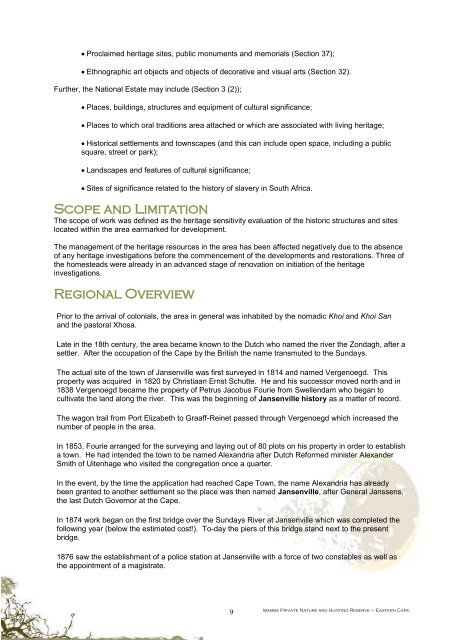Heritage Impact Assessment - SAHRA
Heritage Impact Assessment - SAHRA
Heritage Impact Assessment - SAHRA
You also want an ePaper? Increase the reach of your titles
YUMPU automatically turns print PDFs into web optimized ePapers that Google loves.
Proclaimed heritage sites, public monuments and memorials (Section 37);Ethnographic art objects and objects of decorative and visual arts (Section 32).Further, the National Estate may include (Section 3 (2));Places, buildings, structures and equipment of cultural significance;Places to which oral traditions area attached or which are associated with living heritage;Historical settlements and townscapes (and this can include open space, including a publicsquare, street or park);Landscapes and features of cultural significance;Sites of significance related to the history of slavery in South Africa.Scope and LimitationThe scope of work was defined as the heritage sensitivity evaluation of the historic structures and siteslocated within the area earmarked for development.The management of the heritage resources in the area has been affected negatively due to the absenceof any heritage investigations before the commencement of the developments and restorations. Three ofthe homesteads were already in an advanced stage of renovation on initiation of the heritageinvestigations.Regional OverviewPrior to the arrival of colonials, the area in general was inhabited by the nomadic Khoi and Khoi Sanand the pastoral Xhosa.Late in the 18th century, the area became known to the Dutch who named the river the Zondagh, after asettler. After the occupation of the Cape by the British the name transmuted to the Sundays.The actual site of the town of Jansenville was first surveyed in 1814 and named Vergenoegd. Thisproperty was acquired in 1820 by Christiaan Ernst Schutte. He and his successor moved north and in1838 Vergenoegd became the property of Petrus Jacobus Fourie from Swellendam who began tocultivate the land along the river. This was the beginning of Jansenville history as a matter of record.The wagon trail from Port Elizabeth to Graaff-Reinet passed through Vergenoegd which increased thenumber of people in the area.In 1853, Fourie arranged for the surveying and laying out of 80 plots on his property in order to establisha town. He had intended the town to be named Alexandria after Dutch Reformed minister AlexanderSmith of Uitenhage who visited the congregation once a quarter.In the event, by the time the application had reached Cape Town, the name Alexandria has alreadybeen granted to another settlement so the place was then named Jansenville, after General Janssens,the last Dutch Governor at the Cape.In 1874 work began on the first bridge over the Sundays River at Jansenville which was completed thefollowing year (below the estimated cost!). To-day the piers of this bridge stand next to the presentbridge.1876 saw the establishment of a police station at Jansenville with a force of two constables as well asthe appointment of a magistrate.9Ibamba Private Nature and Hunting Reserve – Eastern Cape
















